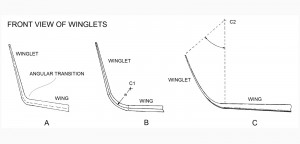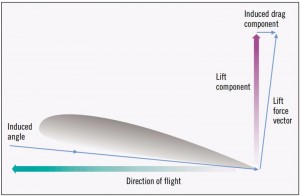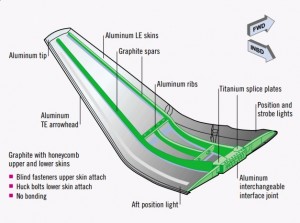Wingtip devices are usually intended to improve the efficiency of fixed-wing aircraft. There are several types of wingtip devices, and although they function in different manners, the intended effect is always to reduce the aircraft’s drag by partial recovery of the tip vortex energy.
The high pressure on the lower surface of the wing creates lateral airflow outwards or away from the fuselage towards the wingtip where, on account of relatively lower air pressure above the wing, tends to spill over and swirl around the wingtip to form a vortex creating additional drag described as “induced drag” thereby reducing aerodynamic efficiency of the wing. Inspiration for the design came from birds observed to curl their wingtip feathers upward when in need of high lift. A well designed winglet rises vertically and is swept back such that it significantly reduces the size of the wingtip vortex thus reducing induced drag.
Fig 1: Difference in vortices with and without winglets
Fig 2:The different popular winglets: A, the conventional winglet sporting an angular transition between the wing and the winglet. B, A Blended winglet with the transition being the arc of a circle whose centre is at “C1″. C, an Elliptical Winglet, which transition and winglet forms part of an ellipse centred at “C2″.
- Fig. 3 Induce Drag
The aft component of this the lift vector is the induced drag (fig. 3). The magnitude of the induced drag is determined by the spanwise distribution of vortices shed downstream of the wing trailing edge (TE), which is related in turn to the spanwise lift distribution. Induced drag can be reduced by increasing the horizontal span or the vertical height of the lifting system (i.e., increasing the length of the TE that sheds the vortices). The winglets increase the spread of the vortices along the TE, creating more lift at the wingtips. The result is a reduction in induced drag. The maximum benefit of the induced drag reduction depends on the spanwise lift distribution on the wing. Theoretically, for a planar wing, induced drag is optimized with an elliptical lift distribution that minimizes the change in vorticity along the span. For the same amount of structural material, nonplanar wingtip devices can achieve a similar induced drag benefit as a planar span increase.
Selection of the wingtip device depends on the specific situation and the airplane model. The aerodynamic advantage of a blended winglet is in the transition from the existing wingtip to the vertical winglet. The blended winglet allows for the chord distribution to change smoothly from the wingtip to the winglet, which optimizes the distribution of the span load lift and minimizes any aerodynamic interference or airflow separation.
Winglets have the potential to give the following benefits:
- Improved climb gradient. This will enable a higher RTOW* from climb limited airports (hot, high or noise abatement) or obstacle limited runways.
- Reduced climb thrust. A winglet equipped aircraft can typically take a 3% derate over the non-winglet equivalent aircraft. This can extend engine life and reduce maintenance costs.
- Environmentally friendly. The derate, if taken, will reduce the noise footprint by 6.5% and NOx emissions by 5%. This could give savings on airport noise quotas or fines.
- Reduced cruise thrust. Cruise fuel flow is reduced by up to 6% giving savings in fuel costs and increasing range.
- Improved cruise performance. Winglets can allow aircraft to reach higher levels sooner. Air Berlin notes, “Previously, we’d step-climb from 35,000 to 41,000 feet. With Blended Winglets, we can now climb direct to 41,000 feet where traffic congestion is much less and we can take advantage of direct routings and shortcuts which we could not otherwise consider.”
- Winglets bring a modern look and feel to aircraft, and improve customers’ perceptions of the airline.
*The MTOW is your Structural max take off weight(real weight)
if you have appreciated this post, please click on the banner below, thanks.



